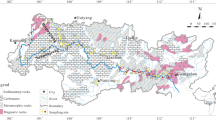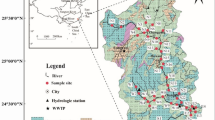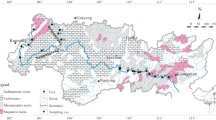Abstract
With the aim of elucidating the spatial and seasonal behaviors of rare earth elements (REEs), we investigated the dissolved REE concentrations of surface water collected during four seasons from middle, lower reaches and estuary of the Minjiang River, southeastern China. The results display that the REE abundances in Minjiang River, ranging from 3.3–785.9 ng/L, were higher than those of many of the major global rivers. The total REE concentrations (ΣREE) were seasonally variable, averaging in 5 937.30, 863.79, 825.65 and 1 065.75 ng/L during second highest flow (SHF), normal flow (NF), low flow (LF) and high flow (HF) season, respectively. The R(L/M) and R(H/M) ratios reveal the spatial and temporal variations of REE patterns, and particularly vary apparently in the maximum turbidity zone and estuary. REE patterns of dissolved loads are characterized by progressing weaker LREEs-enrichment and stronger HREEsenrichment downstream from middle reaches to estuary during all four seasons. Comparing with NF and LF seasons, in which REE patterns are relatively flat, samples of SHF season have more LREE-enriched and HREE-depleted patterns that close to parent rocks, while samples of HF season are more LREEs-depleted and HREE-enriched. REE fractionations from the middle to lower reaches are stronger in the SHF and HF seasons than those in NF and LF seasons. Generally, spatial and seasonal variations in REE abundance and pattern are presumably due to several factors, such as chemical weathering, mixture with rainfall and groundwater, estuarine mixing, runoff, biological production and mountain river characters, such as strong hydrodynamic forces and steep slopes. The highest Gd/Gd * always occurs at north ports during all four seasons, where most of the large hospitals are located. This suggests Gd anomalies are depended on the density of modern medical facilities. Y/Ho ratios fluctuate and positively correlate to salinity in estuary, probably because of the geochemical behavior differences between Y and Ho.
Similar content being viewed by others
References
Bagard M L, Chabaux F, Pokrovsky O S, Viers J, Prokushkin A S, Stille P, Rihs S, Schmitt A D, Dupré B. 2011. Seasonal variability of element fluxes in two Central Siberian rivers draining high latitude permafrost dominated areas. Geochimica et Cosmochimica Acta, 75 (12): 3 335–3 357.
Bau M, Dulski P, Moller P. 1995. Yttrium and holmium in South Pacific seawater: vertical distribution and possible fractionation mechanisms. Oceanographic Literature Review, 11 (1): 1–15.
Bau M, Dulski P. 1996. Anthropogenic origin of positive gadolinium anomalies in river waters. Earth and Planetary Science Letters, 143 (1–4): 245–255.
Bau M, Koschinsky A, Dulski P, Hein J R. 1996. Comparison of the partitioning behaviours of yttrium, rare earth elements, and titanium between hydrogenetic marine ferromanganese crusts and seawater. Geochimica et Cosmochimica Acta, 60 (10): 1 709–1 725.
Davranche M, Pourret O, Gruau G, Dia A. 2004. Impact of humate complexation on the adsorption of REE onto Fe oxyhydroxide. Journal of Colloid and Interface Science, 277 (2): 271–279.
Duncan T, Shaw T J. 2003. The mobility of rare earth elements and redox sensitive elements in the groundwater/seawater mixing zone of a shallow coastal aquifer. Aquatic Geochemistry, 9 (3): 233–255.
Duvert C, Cendón D I, Raiber M, Seidel J L, Cox M E. 2015. Seasonal and spatial variations in rare earth elements to identify inter-aquifer linkages and recharge processes in an Australian catchment. Chemical Geology, 396: 83–97.
Elderfield H, Greaves M J. 1982. The rare earth elements in seawater. Nature, 296 (5854): 214–219.
Elderfield H, Upstill-Goddard R, Sholkovitz E R. 1990. The rare earth elements in rivers, estuaries, and coastal seas and their significance to the composition of ocean waters. Geochimica et Cosmochimica Acta, 54 (4): 971–991.
Goldstein S J, Jacobsen S B. 1988. Rare earth elements in river waters. Earth and Planetary Science Letters, 89 (1): 35–47.
Hagedorn B, Cartwright I, Raveggi M, Maas R. 2011. Rare earth element and strontium geochemistry of the Australian Victorian Alps drainage system: evaluating the dominance of carbonate vs. aluminosilicate weathering under varying runoff. Chemical Geology, 284 (1–2): 105–126.
Han G L, Liu C Q. 2007. Dissolved rare earth elements in river waters draining karst terrains in Guizhou Province, China. Aquatic Geochemistry, 13 (1): 95–107.
Haskin L A, Wildeman T R, Haskin M A. 1968. An accurate procedure for the determination of the rare earths by neutron activation. Journal of Radioanalytical Chemistry, 1 (4): 337–348.
Hathorne E C, Haley B, Stichel T, Grasse P, Zieringer M, Frank M. 2012. Online preconcentration ICP-MS analysis of rare earth elements in seawater. Geochemistry, Geophysics, Geosystems, 13 (1): Q01020.
He J, Lü C W, Xue H X, Liang Y, Bai S, Sun Y, Shen L L, Mi N, Fan Q Y. 2010. Species and distribution of rare earth elements in the Baotou section of the Yellow River in China. Environmental Geochemistry and Health, 32 (1): 45–58.
Hoyle J, Elderfield H, Gledhill A, Greaves M. 1984. The behaviour of the rare earth elements during mixing of river and sea waters. Geochimica et Cosmochimica Acta, 48 (1): 143–149.
Jian X, Guan P, Zhang W, Feng F. 2013. Geochemistry of Mesozoic and Cenozoic sediments in the northern Qaidam basin, northeastern Tibetan Plateau: implications for provenance and weathering. Chemical Geology, 360–361: 74–88.
Jin G E, Hong X Y, Wang X X, Yao W S, Zhang J Y, Gong Z B. 2010. Geochemical characteristics of rare earth elements in Jiulongjiang Estuary. Journal of Oceanography in Taiwan Strait, 29 (3): 304–313. (in Chinese with English abstract)
Lawrence M G, Kamber B S. 2006. The behaviour of the rare earth elements during estuarine mixing—revisited. Marine Chemistry, 100 (1–2): 147–161.
Leybourne M I, Johannesson K H. 2008. Rare earth elements (REE) and yttrium in stream waters, stream sediments, and Fe-Mn oxyhydroxides: fractionation, speciation, and controls over REE + Y patterns in the surface environment. Geochimica et Cosmochimica Acta, 72 (24): 5 962–5 983.
Li D C, Wang D H, Peng A. 2001. Preliminary estimates of the distribution and source of REEs in dustfall and rain in Northwest skirt Beijing. Acta Scientiae Circumstantiae, 21 (5): 640–642. (in Chinese with English abstract)
Li Y C, Gong Z B, Li J, Wen Y Y, Wang T. 2005. Inductively coupled plasma-mass spectrometric determination of rare earth elements in estuarine water with co-precipitation pre-concentration. Journal of Instrumental Analysis, 24 (1): 12–16. (in Chinese with English abstract)
Liu C Z, Jia H L, Chen X F. 2001. Sedimentary texture and sedimentation in the Minjiang river estuary. Oceanologia et Limnologia Sinica, 32 (2): 177–184. (in Chinese with English abstract)
Meng X L, Ji H B. 2007. Contents and distribution pattern of dissolved rare earth elements in Ganjiang River in the southern Jiangxi Province. Journal of the Chinese Rare Earth Society, 25 (5): 625–631. (in Chinese with English abstract)
Milliman J D, Farnsworth K L. 2011. River Discharge to the Coastal Ocean—A Global Synthesis. Cambridge University Press, New York. 392p.
Möller P, Dulski P, Savascin Y, Conrad M. 2004. Rare earth elements, yttrium and Pb isotope ratios in thermal spring and well waters of West Anatolia, Turkey: a hydrochemical study of their origin. Chemical Geology, 206 (1–2): 97–118.
Möller P, Knappe A, Dulski P. 2014. Seasonal variations of rare earths and yttrium distribution in the lowland Havel River, Germany, by agricultural fertilization and effluents of sewage treatment plants. Applied Geochemistry, 41: 62–72.
Noack C W, Dzombak D A, Karamalidis A K. 2014. Rare earth element distributions and trends in natural waters with a focus on groundwater. Environmental Science & Technology, 48 (8): 4 317–4 326.
Nozaki Y, Lerche D, Alibo D S, Snidvongs A. 2000. The estuarine geochemistry of rare earth elements and indium in the Chao Phraya River, Thailand. Geochimica et Cosmochimica Acta, 64 (23): 3 983–3 994.
Nozaki Y, Zhang J, Amakawa H. 1997. The fractionation between Y and Ho in the marine environment. Earth and Planetary Science Letters, 148 (1–2): 329–340.
Oliva P, Viers J, Dupré B. 2003. Chemical weathering in granitic environments. Chemical Geology, 202 (3–4): 225–256.
Osborne A H, Haley B A, Hathorne E C, Plancherel Y, Frank M. 2015. Rare earth element distribution in Caribbean seawater: continental inputs versus lateral transport of distinct REE compositions in subsurface water masses. Marine Chemistry, 177: 172–183.
Qu C H, Chen C Z, Yang J R, Wang L Z, Lu Y L. 1993. Geochemistry of dissolved and particulate elements in the major rivers of China (The Huanghe, Changjiang, and Zhunjiang rivers). Estuaries, 16 (3): 475–487.
Raso M, Censi P, Saiano F. 2013. Simultaneous determinations of zirconium, hafnium, yttrium and lanthanides in seawater according to a co-precipitation technique onto iron-hydroxide. Talanta, 116: 1 085–1 090.
Rousseau T C C, Sonke J E, Chmeleff J, Candaudap F, Lacan F, Boaventura G, Seyler P, Jeandel C. 2013. Rare earth element analysis in natural waters by multiple isotope dilution—sector field ICP-MS. Journal of Analytical Atomic Spectrometry, 28 (4): 573–584.
Shiller A M. 1997. Dissolved trace elements in the Mississippi River: seasonal, interannual, and decadal variability. Geochimica et Cosmochimica Acta, 61 (20): 4 321–4 330.
Shiller A M. 2002. Seasonality of dissolved rare earth elements in the lower Mississippi River. Geochemistry, Geophysics, Geosystems, 3 (11): 1–14.
Sholkovitz E R. 1995. The aquatic chemistry of rare earth elements in rivers and estuaries. Aquatic Geochemistry, 1 (1): 1–34.
Tang J W, Johannesson K H. 2005. Rare earth element concentrations, speciation, and fractionation along groundwater flow paths: the carrizo sand (Texas) and upper floridan aquifers. In: Johannesson K H ed. Rare Earth Elements in Groundwater Flow Systems. Springer, Netherlands. p.223-251.
Tricca A, Stille P, Steinmann M, Kiefel B, Samuel J, Eikenberg J. 1999. Rare earth elements and Sr and Nd isotopic compositions of dissolved and suspended loads from small river systems in the Vosges mountains (France), the river Rhine and groundwater. Chemical Geology, 160 (1–2): 139–158.
Tweed S O, Weaver T R, Cartwright I, Schaefer B. 2006. Behavior of rare earth elements in groundwater during flow and mixing in fractured rock aquifers: an example from the Dandenong Ranges, southeast Australia. Chemical Geology, 234 (3–4): 291–307.
Verplanck P L, Nordstrom D K, Taylor H E, Kimball B A. 2004. Rare earth element partitioning between hydrous ferric oxides and acid mine water during iron oxidation. Applied Geochemistry, 19 (8): 1 339–1 354.
Wang Z G, Yu X Y, Zhao Z H et al. 1989. Geochemistry of Rare Earth Elements. Science Press, Beijing, China. p.321-342. (in Chinese)
Wang Z L, Liu C Q. 2008. Geochemistry of rare earth elements in the dissolved, acid-soluble and residual phases in surface waters of the Changjiang Estuary. Journal of Oceanography, 64 (3): 407–416.
White A F, Blum A E. 1995. Effects of climate on chemical weathering in watersheds. Geochimica et Cosmochimica Acta, 59 (9): 1 729–1 747.
Wu M Q. 1983. REE Geochemistry of sea-floor sediments from the Taiwan shallow, China. Geochimica, 12 (3): 303–313. (in Chinese with English abstract)
Wu M X, Li X H, Liu Y, Wei K Q. 2003. Rare earth elements in groundwaters from Fogang granitoid weathering crust of Baisha, Yingde, Guangdong Province, China. Geochimica, 32 (4): 335–342. (in Chinese with English abstract)
Xu Y H, Chen J. 2010. Uranium-lead dating of detrial zircons from the Minjiang and Jiulong Estuaries in the western coast of the Taiwan Strait: implication for its provenance. Acta Oceanologica Sinica, 32 (4): 110–117. (in Chinese with English abstract)
Xu Z F, Han G L. 2009. Rare earth elements (REE) of dissolved and suspended loads in the Xijiang River, South China. Applied Geochemistry, 24 (9): 1 803–1 816.
Ye X, Chen J, Ji W D, Li D Y. 2011. Research the biogeochemical processes of nutrients in Minjiang Estuary. Environmental Science, 32 (2): 375–383. (in Chinese with English abstract)
Yin J N, Xiao K Y, Wang X Q, Liu Y, Ding J H. 2013. Quantified analysis and prognosis for rare earth minerals potential in China. Journal of Geology, 37 (3): 378–381. (in Chinese with English abstract)
Zhang B, Guo Z R, Gao A G, Yuan X J, Li K P. 2013. An Analysis of the Interaction between River Water, Groundwater and Seawater in Minjiang River estuary Region, Fujian Province, Based on Stable Isotopes D and 18 O. Acta Geoscientica Sinica, 34 (2): 213–222.
Zhang W, Guan P, Jian X, Feng F, Zou C N. 2014. In situ geochemistry of Lower Paleozoic dolomites in the northwestern Tarim basin: implications for the nature, origin, and evolution of diagenetic fluids. Geochemistry, Geophysics, Geosystems, 15 (7): 2 744–2 764.
Zheng X Y, Plancherel Y, Saito M A, Scott P M, Henderson G M. 2016. Rare earth elements (REEs) in the tropical South Atlantic and quantitative deconvolution of their nonconservative behavior. Geochimica et Cosmochimica Acta, 177: 217–237.
Zhou G H, Sun B B, Zeng D M, Wei H L, Liu Z Y, Zhang B M. 2012. Hydrogeochemical characteristics of major estuaries in eastern China: physicochemical indicators and soluble element concentrations of river water. Geology in China, 39 (2): 283–294. (in Chinese with English abstract)
Zhu X X, Lin J J, Gao A G, Zhu M. 2017. Simultaneous determinations of rare earth elements by online preconcentration system coupled with ICP-MS. Atomic Spectroscopy (in Press).
Acknowledgement
We thank Engineer WU Wenxi and WANG Danhong in the Key Laboratory of Inspection and Quarantine Technique in Fujian Province, China, for their help in the REE measurements.
Author information
Authors and Affiliations
Corresponding author
Additional information
Supported by the National Natural Science Foundation of China (No. 41376050)
Rights and permissions
About this article
Cite this article
Zhu, X., Gao, A., Lin, J. et al. Seasonal and spatial variations in rare earth elements and yttrium of dissolved load in the middle, lower reaches and estuary of the Minjiang River, southeastern China. J. Ocean. Limnol. 36, 700–716 (2018). https://doi.org/10.1007/s00343-018-6207-9
Received:
Accepted:
Published:
Issue Date:
DOI: https://doi.org/10.1007/s00343-018-6207-9




